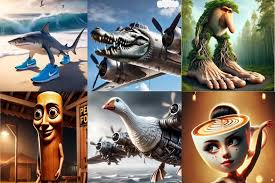The Phenomenon of Cartoon Anomalies: Surreal Distortions in Animation
Cartoon anomalies—those strange distortions, bizarre character forms, and surreal narrative breaks—have become more than just quirks in animation. They embody a rich, complex phenomenon that straddles psychology, technology, art, and culture. This article deeply explores their origins, impact, implications, and future, drawing on international research, statistics, and illustrative examples.
1. Defining Cartoon Anomalies
Cartoon anomalies refer to intentional or accidental distortions that break conventional animation rules:
-
Visual distortions: extra limbs, odd proportions, or surreal physics.
-
Narrative anomalies: abrupt shifts in tone, genre, or logic.
-
Stylistic anomalies: sudden changes in style or animation inconsistency.
These anomalies enrich cartoons by playing with viewer expectations and emotional responses. They can amuse, unsettle, or captivate—depending on context.
2. Historical and Technological Context
Anomalies in animation have deep historical roots:
-
"Plausible impossible": Disney animators embraced physical defiance—like static ladders in mid-air—to heighten humor.
-
Subversive media art: Johann Hagler’s research highlights how anomalies emerge from re-purposing animation tech, forging art that challenges norms.
-
Modern AI issues: Today's text-to-image models often generate bizarre skeletal configurations or “visual hallucinations” (e.g. three-legged characters), demonstrating a resurgence of anomalies in generative content.
Animation's creative pulses often lie in these intentional imperfection and anomaly zones.
3. Psychological Impact: The Uncanny and the Surreal
Anomalies can evoke powerful psychological responses:
-
Uncanny valley: When characters resemble reality but fall slightly short, viewers feel eerie discomfort—seen in uncanny CGI like Polar Express.
-
Animated deviance: Research from Carnegie Mellon shows facial anomalies—like disproportionate eyes—capture more attention than body motion errors, as the brain is tuned to faces.
-
Neural engagement: According to cognitive science, anomalies send “prediction errors” to the brain—the unexpected deviations from predictions create attention and emotional response .
Anomalies can be eerie, comic, or thought-provoking, depending on how they confront viewer expectations.
4. Impact on Attention and Executive Function
Recent neuropsychological studies shed light on how anomalies influence development:
-
Toddlers & fantastical content: A clinical study with 18-month-olds found short-term viewing of surreal cartoons impaired inhibitory control—evidenced by struggle in “anti-saccade” tasks.
-
Longer-term behavioral effects: Separate research links excessive cartoon viewing (32 weekly hours) with increased aggression and imitation behaviors among schoolchildren .
While anomalies engage attention, they can overload immature executive functions or reinforce mimicry, raising questions about age-appropriate content.
5. Cultural, Social, and Ethical Dimensions
Anomalies often carry societal commentary:
-
Subtle biases & cultural norms: Cartoons are vehicles of cultural messages; distortions can challenge or reinforce stereotypes .
-
Political satire: Single-panel cartoons use statistical anomalies to mock demographics, election polling, and societal absurdities .
These anomalies serve as both reflection and critique of the broader social landscape.
6. Purposes Behind Cartoon Anomalies
Cartoon anomalies are not accidental; they serve defined creative objectives:
-
Humor and absurdity: Slapstick physics (“Coyote Interruptus”) subverts realism for comedic surprise.
-
Thematic exaggeration: Distorted forms symbolize inner emotions—fear, love, anxiety.
-
Emotional dissonance: Surreal elements evoke reflective or uneasy emotional engagement.
-
Experimental storytelling: Artists twist norms to explore identity, perception, or social critique .
7. Statistical Context: How Much Anomaly Is Too Much?
Quantified analyses help understand anomaly prevalence:
-
An analysis of international educators found most cartoon protagonists were coded as “helpful” (18%), “sympathetic” (12%), and “friendly” (12%), with ambiguity left for anomalous side characters.
-
A study of toddler viewing habits showed that extraordinary deviation in content strongly correlated with immediate decline in self-control by ~10–15% after a 7-minute session.
Statistics show anomaly intensity is a measurable factor in content design and psychological impact.
8. Case Studies in Cartoon Anomalies
A. “Mystic Duck: Guardian of the Spiral Vortex”
A surreal web-animation featuring a cosmic duck with nebula-patterned feathers. By creating absurd absurdity, it leverages anomaly for cosmic humor.
B. Surreal AI-generated animations
Modern AI often produces uncanny anatomical features: such as three eyes or floating limbs. Though not artistically intended, they offer raw anomaly that captures attention.
C. Polar Express and uncanny CGI
A prime example of animation eeriness: CGI characters with almost-human eyes triggered discomfort, impacting audience reception .
9. Designing with Anomalies: Best Practices
For creators, navigating anomalies requires care:
-
Know your audience: Toddlers vs. teens respond differently; anomalies may excite or overwhelm.
-
Balance: novelty vs. coherence: Use anomalies sparingly to surprise; avoid sensory overload.
-
Symbolic clarity: Ensure anomalies align with emotional or thematic intent.
-
Iterative feedback: Testing on target viewers helps gauge psychological and narrative effectiveness.
10. Future of Cartoon Anomalies
What lies ahead for animated anomalies?
-
AI-detected hallucinations: New systems using pose-aware detectors aim to correct unintended anomalies in AI-generated animation.
-
Intentionally surreal animations: Artists will push creative limits for meaning-making and aesthetic exploration.
-
Adaptive anomaly control: Future platforms may adjust anomaly levels based on viewer age or engagement patterns.
The boundary between “creative surprise” and “disturbing glitch” remains central to emerging technology and aesthetic practice.
Conclusion
Cartoon anomalies are a multifaceted phenomenon:
-
They challenge cognitive expectations and stir emotional resonance.
-
They can enrich humor and surprise—or test viewer comfort.
-
They are a tool for critique, reflection, and the surreal.
-
They require responsible design when targeted at young audiences.
Understanding anomaly’s place—from Disney’s ladders to AI’s accidental limbs—reveals how animation continues to charm, unsettle, and innovate at the edges of perception.
References
-
Mori, M. (1970) – Uncanny valley concept
-
Toddler anti-saccade study (2004) – effect of fantastical cartoons
-
CMU research – saliency of facial anomalies
-
Hagler, J. (2019) – anomalies in media art
-
AI hallucination detection in cartoons (2024)
-
Cartoon physics principles – “plausible impossible”


.jpeg)
Comments
Post a Comment